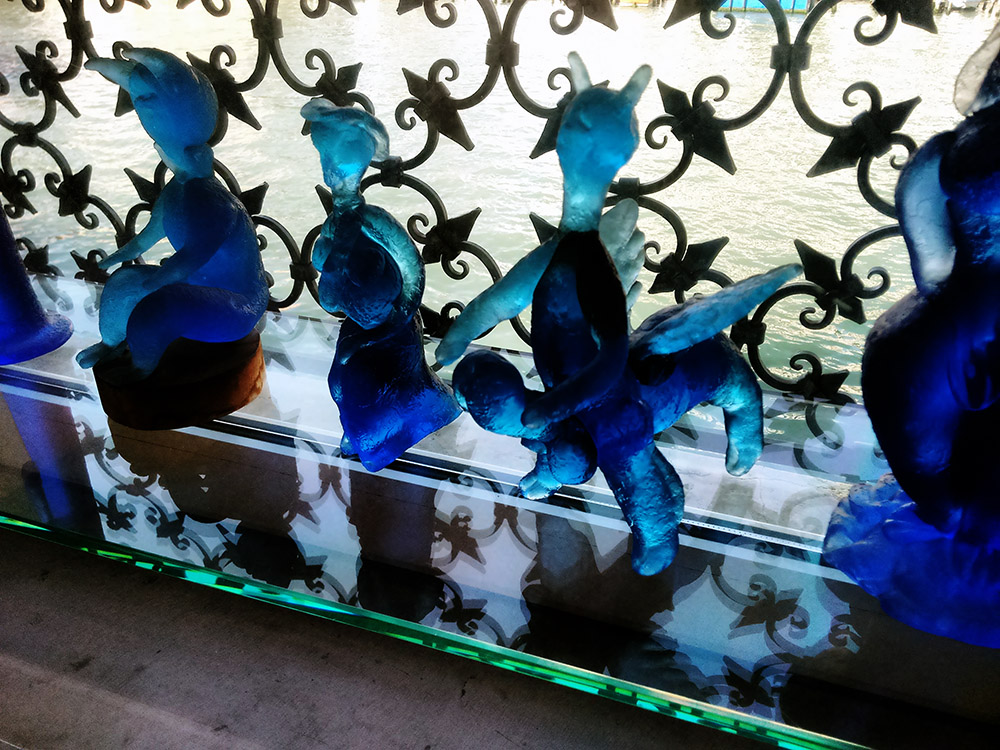Off to Venice again. You've seen San Giorgio Maggiore before. It's an island just across the water from St Mark's Square, visible in the shot above. Look at those people in the bottom-left. Little did they know what fate had in store for them. When I went back to Venice last month all those people were gone. In their place were other people, different people. Only I remained.
San Giorgio Maggiore is Italian for Saint George Major, or Saint George The Biggest. There are two islands called San Giorgio in the Venetian lagoon. The other one - San Giorgio in Alga, or "Saint George in the Seaweed" - was swept by fire in 1799. During the Second World War it was used to train German frogmen and nowadays it is abandoned. There's not much to see; it's surprising how many of Venice's islands are abandoned. I imagine that the cost of plumbing and wiring them up is prohibitive. Are they used by drug dealers? Do they have pop-up brothels? I don't know.
The view from atop the church.
I saw Venice several times before popping over the water to San Giorgio Maggiore. It was always there in the background but I never thought about it. How do you get there? You take the number 2 from San Zaccaria. The island is tiny but there's a surprising amount of things to see. There's a church with a tower, an art gallery, an occasional outdoors art exhibit, some boats, and a former monastery which is now the home of the Cini Foundation.
The church.
The foundation was created by Vittorio Cini, who was comfortable with fascism but managed to sail through the Second World War without being beaten to death and hung from the forecourt of a petrol station. The foundation also owns the Palazzo Cini, just along from the Peggy Guggenheim Museum, and part of me wonders if the foundation is in fact a huge tax dodge. It hosted the G7 twice, so presumably the current owners are pally with the world's great and good.
Both taken with an Olympus Stylus Epic and some Fuji Velvia last year. This is Hiroshi Sugimoto's "Glass Tea House Mondrian". If you have been bad, they lock you inside it until you starve.
The view north-northeast.
The G7 comprises France, Germany, Italy, and of course the United Kingdom, plus Canada and the United States and Japan, but not mean old Russia any more. Together we account for almost half of the world's GDP. The other 189 countries chip in, but we are the masters. The wise men who guide humanity into a golden future. And women. Perhaps one day there will be a G196, but hopefully with the G7 in charge that will never happen.
The back half of the island has a guided tour which I didn't attend, but the front half has an interesting art gallery and of course the church, which is the main event. There are no shops and if you want a picnic you'll need to bring a packed lunch or a fishing rod or an air rifle or some livestock.
The church now has a floating metal hand; last year it had a metal head (pictured), but not this year.
The opposite direction. Dead ahead the islands of La Grazia (formerly a rubbish heap, now abandoned, although imminently the site of a hotel), and San Clemente, which actually is a hotel. Imagine all the people in centuries gone by, in little boats, who got lost in fog and kept going, never to be seen again.
Access to the top of the church is via a lift, and only a lift. It costs €6 although I wasn't paying attention. The top has views in all four directions. It shuts at 18:00, which is just before sunset in late September. Despite its proximity to one of the world's most popular tourist destinations San Giorgio is a mellow place. Returning to mainland Venice is a bit depressing, because once more you are surrounded by teeming crowds of tourists, and you are one of them. The illusion is shattered.
Bonus Beats: The Peggy Guggenheim Collection
Peggy Guggenheim had a neat art collection which she housed in a neat house. She is buried in the grounds along with her dogs. The last dog was painlessly euthanised in order to be with her forever along with her manservants. It's romantic to imagine travelling the world, collecting art and houses along the way, but alas even in Peggy Guggenheim's day that was very expensive, so you just have to imagine it.
The house is a highly effective piece of show-offery and on another level it's also a battleground of warring financial entities, because it's slowly being taken over by the Rudolph B Schulhof collection. It's always entertaining when rich people fight each other.
The collection has a cafe, which I didn't visit because I was starting to run out of change, and a gift shop. I'm not sure if it's naff or kitsch. Perhaps it's both. Nitsch.
Peggy Guggenheim famously had a lot of sex. For all the snark present in this post she *did* have fantastic taste in art.
De Chirico's The Red Tower is fascinating. I want to explore that world. The absence of people. The long shadows. The way that the horse statue is only just visible, as if we were moving forward and the statue was just coming into view.
On closer inspection the tower's door is enormous. Was it built by giants? What is the tower for?
Many years later the haunting emptiness of De Chirico's work inspired the cover art of the Japanese video game Ico (famously the international artwork was rubbish).


















